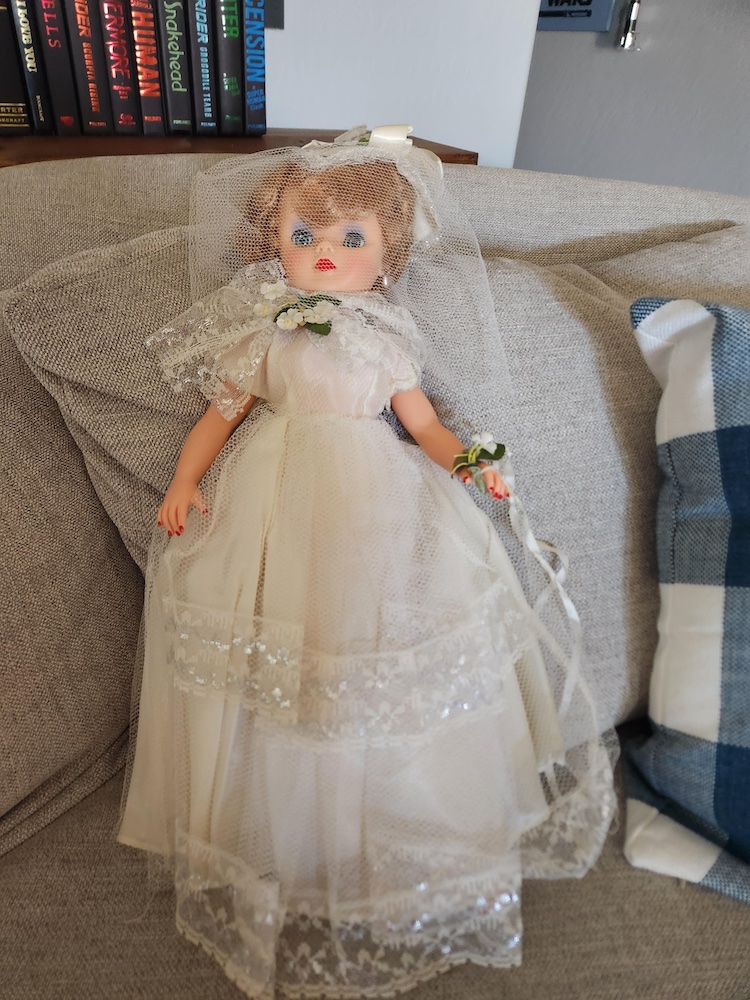Bride Doll

When I opened that antique dresser drawer, a stiff, corpse-like doll stared up at 12-year-old me. I reeled back in horror, and I have never liked dolls from that day. So as fate would have it, I have an online reputation as a doll expert. A case in point is a photo sent to me by KM of a bride doll given to her by her dear grandmother in the 1960s. She can’t remember the maker: I can tell you it is the Madame Alexander Doll Company. What fascinated me was the impeccable condition of the doll and wedding gown after 60 years. Girls held bride dolls in high esteem; this article explains WHY.
A wedding is both an anxiety-producing occasion and a pinnacle event around the bride’s appearance. Thus, what is supposed to be a perfect day with its beautiful tableaux of gown, hair, makeup, and jewelry is often stressful. Bride dolls reflect both polarities. An example on the horror side is Disney’s 2023 creation of The Haunted Mansion Bride Doll, who is a beautiful bride, but wields a bloody ax, even as she is dressed in a mermaid style wedding gown and veil. Shades of Miss Havisham in Great Expectations – weddings can be murder!
For thousands of years, in those cultures where young pre-adolescent girls were promised in marriage, the bride doll was a necessity. She was dressed in a beaded headdress and mask, in flowing ethnic colorful robes, and given to the girl to help qualm oncoming anxiety. The Israel Museum of Jerusalem had a show of these dolls from Yemen and Morocco; “Girl-Bride-Doll.”
Contrast this with the expensive bride dolls made in 1890-1910 for the wealthy young ladies of Germany and America by Simon & Halbig of Thüringen. This bride doll, although given as a gift to a little girl, was modeled after a grown woman’s body and dressed in the latest 1900s wedding styles. These dolls had bisque porcelain heads as opposed to high-fired china porcelain heads, so that the ‘skin’ was not glazed but ‘natural’ looking.
Speaking of natural-looking mature female bride dolls, the doll owned by KM can ‘walk’ and turn her head at the same time, as well as bend her knees, a mid-20th c. engineering feat. She has vinyl face and arms, plastic body and jointed legs, open and shut blue eyes with fringed eyelashes, red lipstick and fingernail polish, short Marilyn-style rooted blonde hair, pearl earrings, and “high heeled” feet, arched so that a spike heel could be worn, affixed with elastic. Once again, what amazes me is the condition of this doll, with the silk floral bouquet still in its hand.
Dolls have been associated with weddings for hundreds of years, since the first baker placed two wedding dolls on a cake. The wedding topper reached peak popularity in the 1930s when the Kewpie celluloid doll was the rage. These bride dolls were horrifically cute-ugly, squat, small, and very inexpensive, and came dressed in a white gown and veil. In the National Museum of Australia there’s a 1930s Kewpie doll in the collection that decorated the hood of a honeymoon car, and I learned that in New Zealand and Australia, it was a tradition to stick a bride doll on the hood of the ‘motor,’ carrying through to the late 1970s when an Aussie Barbie was dressed in white and strapped to the hood of the honeymoon car. Russian automotive decoration around nuptials also includes a bride doll! Italy seems to have the only sane car-association around a wedding; someone decorates the grill of the car with flowers to wish the couple a sweet and beautiful ride through life.
Now to the most married doll in history: Barbie. Mattel through the years has created over 50 celebrity bride dolls based on Barbie’s proportions. You have not lived through the last century without seeing the Princess Diana doll. Other companies jumped on the celebrity bride bandwagon, producing a spectrum of brides from Queen Victoria to Scarlett O’Hara. Queen Victoria dolls were the first brides to be dressed in white, which didn’t shout “virgin” but was a sign of the family of the bride being rich enough that a dress could be worn ONCE. Previously, gowns were color-appropriate based on the age of the bride. After 26 or so she would not have worn a beige or taupe gown but a GREY one!
The use of an object made in the image of a human takes on deep symbolism. KM’s Madame Alexander bride doll circa 1960s is worth $450 in that perfect condition. Strange that a supposedly fully grown female should have the face of a baby, though it makes total sense given the wishful “projections” this doll represented.







You must be logged in to post a comment.